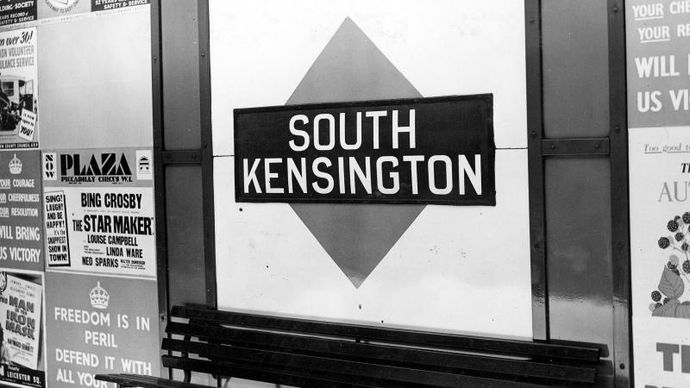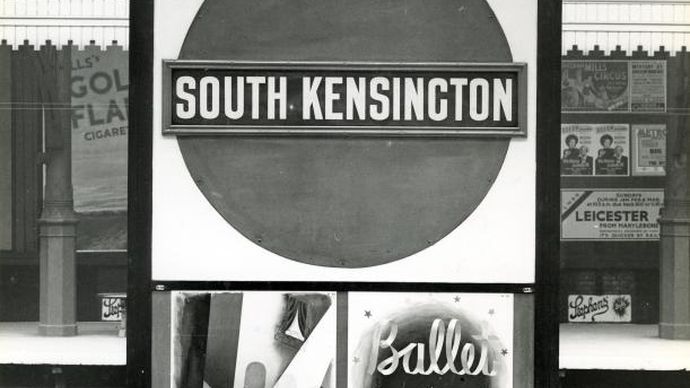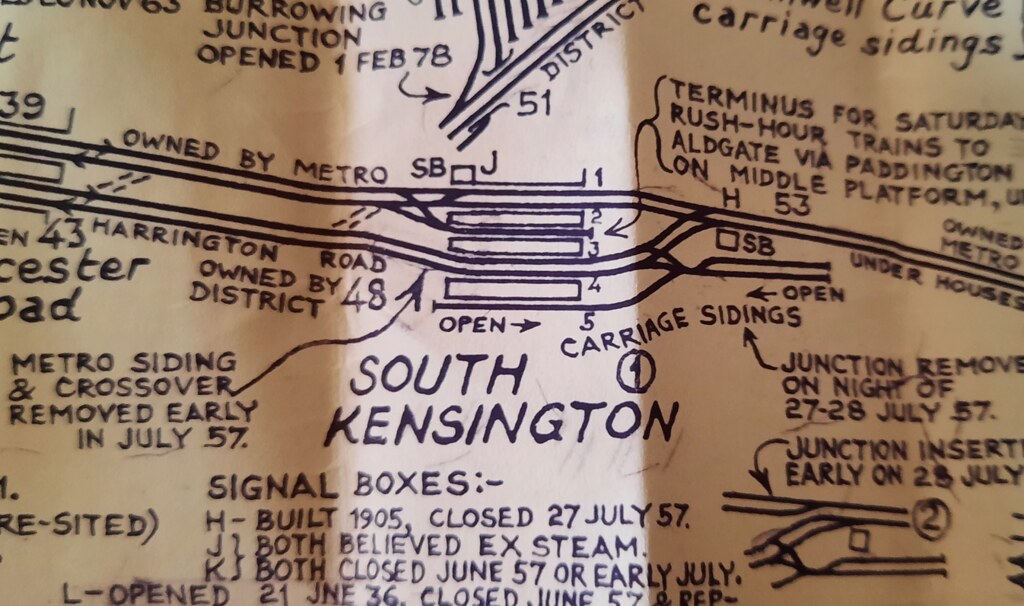|
|
Post by jimbo on Mar 10, 2023 4:23:29 GMT
The Harsig diagrams trace the track and signalling history of this area back to 1936 link. The Metropolitan central bay platform for a New Cross service via Baker Street later provided space for the Piccadilly Line interchange stairs. I wonder the original purpose of the District Line bay platform to the south of the station, which is shown with no direct connection to the running lines, but only indirectly via the eastern sidings. Did this platform originally have a connection to allow short workings to reduce pressure on the Triangle junctions, just as Mansion House bay roads did, and later Tower Hill bay does, relieve pressure on the Minories junctions? |
|
|
|
Post by burkitt on Mar 10, 2023 9:42:01 GMT
|
|
metman
Global Moderator
5056 05/12/1961-23/04/2012 RIP
Posts: 7,421
|
Post by metman on Mar 10, 2023 20:23:05 GMT
This is interesting and I had not really noticed it before. On the diagram it appears quite short, was this the case?
I wondered if it was a loco spur or uncoupling point?
How long was this bay, does anyone remember it?
|
|
|
|
Post by jimbo on Mar 11, 2023 5:18:12 GMT
The 1893 map apparently shows the length of the District bay road to the stops, which is longer than both sides of the Met island platform, but not as long as the District through roads or the northern Met inner rail platform. The 1914 map apparently shows all platforms now ending at the same point to the west, except for the Met inner rail platform. The Met outer rail and bay island platform seems to have been extended to the east, as has also the District westbound and bay platform, even further. Back in those days trains would routinely berth up against the stops with no terminal protection, as they did at Baker Street platform 4 until platform lengthening for the S8 stock.
I had a recollection that the District bay was used for a display of rolling stock in connection with the District centenary celebrations in 1968, but perhaps this was only a proposal that came to nothing. The District bay and sidings were lifted following the 1969 rationalisation to the current layout in connection with the provision of escalators for Piccadilly Line interchange.
|
|
|
|
Post by burkitt on Mar 11, 2023 10:51:17 GMT
On the diagram it appears quite short, was this the case?I wondered if it was a loco spur or uncoupling point? Although in the 1914 map the bay appears only long enough to hold a loco, this wouldn't make sense given locos had been made (almost) redundant with electrification. I think the bay actually retains its original length, but it largely hidden under the newly constructed terrace of houses on Pelham Street, which were built on girders over the tracks. Alas this is the failing with relying on a map rather than a proper track diagram. I had a recollection that the District bay was used for a display of rolling stock in connection with the District centenary celebrations in 1968, but perhaps this was only a proposal that came to nothing. I don't know about the 1968 District centenary, but the District's 1928 diamond jubilee definitely was celebrated by a display of rolling stock in the South Kensington bay road. These included an 1881 steam loco, a 4-wheeled third-class carriage 1871, an electric loco from 1905, and driving motor cars from 1905, 1920, and 1928. Staff who had worked on the District since the era of steam haulage were in attendance to show off the exhibited and answer questions. According to MAC Horne's London's District Railway, the exhibit was scheduled to run from 5th-10th November but was so popular it was extended until the 11th, with 96,375 people visiting in total. 10,000 commemorative booklets were handed out, containing a brief history of the line, some facts and statistics, and illustrations and details of the vehicles displayed. I have uploaded scans of the entire booklet here. |
|
|
|
Post by jimbo on Mar 12, 2023 4:42:09 GMT
Many thanks burkitt So the bay road held a display of six items, three of which were standard sized cars. We have no way of knowing if they were a tight fit, or whether there was room for more. |
|
|
|
Post by burkitt on Mar 12, 2023 21:30:13 GMT
I've tried searching the LTM collection for any photos which might show the length of District bay platform. These two are of the western end of the westbound District through platform [ 1949 photo link] [ 1951 photo link]. The bay platform should be in the background somewhere, but it's hard to make out where it starts. These two photos are of the central Met bay platform [ 1949 photo link] [ 1951 photo link] and similarly the District bay is in the background but hard to distinguish. There is a photo of the steam loco in the bay for the 1928 District diamond jubilee display [ photo link] but again it's not apparent from this how long the bay was. Incidentally there are some other fantastic photos of South Kensington station there, including the original overall roof [ photo 1][ photo 2] which makes me regret its demolition, and the amazingly precarious signal cabin [ photo link]. |
|
|
|
Post by spsmiler on Mar 15, 2023 11:41:53 GMT
I did not realise that when the Metropolitan Railway built it they also gave this station arched roofs. They look superb!
By way of contrast Gloucester Road had normal railway style platform canopies. 'Somewhere' I have photos of them, taken when this was still an 'open air' station.
|
|
|
|
Post by Dstock7080 on Mar 15, 2023 11:47:19 GMT
|
|
|
|
Post by spsmiler on Mar 15, 2023 20:43:30 GMT
So I wonder why the overall roof at Gloucester Road was also removed.
|
|
|
|
Post by burkitt on Mar 15, 2023 21:26:23 GMT
I'd need to do some research for the specifics of Gloucester Road, but maintenance of many of the overall roofs seemed to be rather neglected by the Met, leading to them being considered unsafe and demolished around 1900.
|
|
|
|
Post by brigham on Mar 16, 2023 8:32:38 GMT
Sloane Square still remains in a suitable condition for the re-instatement of the overall roof, which I think ought to be done, seeing that no District stations still have one.
It would make the river overbridge more of an interesting feature, too.
|
|
DWS
every second count's
Posts: 2,487
|
Post by DWS on Mar 16, 2023 9:05:50 GMT
Sloane Square still remains in a suitable condition for the re-instatement of the overall roof, which I think ought to be done, seeing that no District stations still have one. It would make the river overbridge more of an interesting feature, too. Earls Court still has a roof over the District line platforms, I know it does not cover the platforms at one end, but back in the day maybe the trains were not as long. |
|
Chris M
Global Moderator
Forum Quizmaster
Always happy to receive quiz ideas and pictures by email or PM
Posts: 19,758
Member is Online
|
Post by Chris M on Mar 16, 2023 9:15:43 GMT
There is also a roof still over the District line platforms at Paddington, Bayswater and Notting Hill Gate.
|
|
|
|
Post by Hutch on Mar 16, 2023 10:54:33 GMT
The northern part of the overall roof at Paddington was removed by German engineers in the early 1940s. The gap called 'Ruins' is now the Aberdeen Steakhouse. |
|
|
|
Post by spsmiler on Mar 16, 2023 20:52:23 GMT
I always thought that this gap in the roof was a ventilation portal
Yes to Sloane Square and Barbican, South Kensington with its twin arched roof would be nice too. Gloucester Road however is too far gone.
|
|
|
|
Post by jimbo on Mar 17, 2023 4:30:46 GMT
Different ownership of the platforms would have been clear from name signs, even up to the War (LT Museum collection):   |
|
|
|
Post by brigham on Mar 17, 2023 8:19:42 GMT
I hope people appreciated they were not just changing trains, but changing 'modes'.
|
|
|
|
Post by revupminster on Mar 17, 2023 9:02:47 GMT
|
|
gantshill
I had to change my profile pic!
Posts: 1,371
|
Post by gantshill on Mar 17, 2023 10:01:38 GMT
That looks like a great historical map. I don't think I've ever seen it before. Where is it from? Are you able to share more of it? Sorry to be asking so many questions. |
|
|
|
Post by revupminster on Mar 17, 2023 10:46:35 GMT
|
|
|
|
Post by spsmiler on Mar 17, 2023 11:32:36 GMT
It seems that Flickr have changed (reduced!) their photo sharing options for images that are copyright. Anyway ... I found a way to make this visible here! This terminus track would have been useful for a service to Paddington via High St Ken to boost train frequency in west London  |
|
|
|
Post by jimbo on Mar 17, 2023 18:09:18 GMT
|
|
|
|
Post by jimbo on Mar 21, 2023 17:53:43 GMT
The Harsig diagrams trace the track and signalling history of this area back to 1936 link. The Metropolitan central bay platform for a New Cross service via Baker Street later provided space for the Piccadilly Line interchange stairs. I wonder the original purpose of the District Line bay platform to the south of the station, which is shown with no direct connection to the running lines, but only indirectly via the eastern sidings. Did this platform originally have a connection to allow short workings to reduce pressure on the Triangle junctions, just as Mansion House bay roads did, and later Tower Hill bay does, relieve pressure on the Minories junctions? So, in electric days this bay was only of use for stabling indirectly from the eastern sidings, but in steam days could have been used for reversing short workings. We have not established its length, but if the through platforms suit 8-car trains, then the bay may have been limited to 6-car trains in electric days. But in earlier steam working the length would also have been occupied by the arriving locomotive, and room must have been left for a loco from one of the then three sidings to connect to the other end for departure. So, this would have limited coaching stock to the equivalent of five or less current cars. Perhaps the bay platform was only of use in the early days of steam working when trains were short, becoming disused as demand built and trains lengthened. This would explain the loss of the direct track connection upon electrification. What prevented the bay from being lengthened? |
|
metman
Global Moderator
5056 05/12/1961-23/04/2012 RIP
Posts: 7,421
|
Post by metman on Mar 23, 2023 19:54:19 GMT
Yes I think you’re right. The early steam coaches were quite short and rigid wheelers so a reasonable number might have fitted into the platform.
|
|
|
|
Post by flippyff on Mar 23, 2023 22:40:44 GMT
If you download the full resolution image of the full map from Revupminster's Flickr, there's four more mini-maps of South Kensington (2 & 3 shown below S.K to Sloan Square and 4 & 5 shown just above Victoria station) showing track slews and dates.
There's an info. box in the top right hand corner which dates the {Edit: original} map as May 1954. Seems to be numbered No. 155. {Edit: A further footnote adds "Numerous small corrections and additions made Mch 71, Nov 79, May 80, Oct 80, Oct 84, Sep 85, ? ? 88, Sep 88.".}
(Any errors / lack of clarity in the above are purely down to me)
Thanks to revupminster for sharing such a wonderful map.
|
|
|
|
Post by jimbo on Mar 24, 2023 4:24:50 GMT
I was wondering how long the Metropolitan Line bay platform was, on the centre line of the station. Wikipedia tells me that it was disused from June 1957, and that Circle Line trains were lengthened from 5-car to 6-car in 1959/60, although Hammersmith & City Line trains were already 6-cars. It seems that 5-car length would therefore have been adequate. The 1893 map linked above makes both bays look similar in length. |
|
roythebus
Pleased to say the restoration of BEA coach MLL738 is as complete as it can be, now restoring MLL721
Posts: 1,275
|
Post by roythebus on Apr 6, 2023 22:52:26 GMT
I'd suggest both bays were the same length as the bay platforms. I'm certain the DR bay and sidings were still there in 1970 when I started as a guard at PG. I don't recall seeing the the Met bay with track. But note on the 1890-ish map there's a west end loco spur on the Met bay which seems to have had access to the inner rail as well as the bay. this would have been for holding the loco that was released from a terminating train after it had departed to the west. The loco on the deprting train would have been off the previous arrival.
|
|



